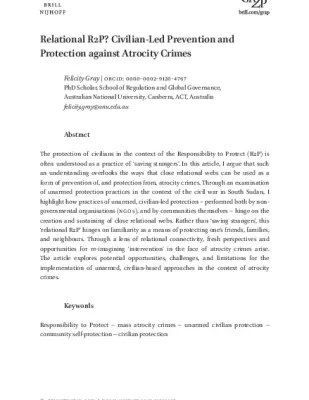The protection of civilians in the context of the Responsibility to Protect (R2P) is often understood as a practice of ‘saving strangers’. In this article, I argue that such an understanding overlooks the ways that close relational webs can be used as a form of prevention of, and protection from, atrocity crimes. Through an examination of unarmed protection practices in the context of the civil war in South Sudan, I highlight how practices of unarmed, civilian-led protection – performed both by non-governmental organisations (ngo s), and by communities themselves – hinge on the creation and sustaining of close relational webs. Rather than ‘saving strangers’, this ‘relational R2P’ hinges on familiarity as a means of protecting one’s friends, families, and neighbours. Through a lens of relational connectivity, fresh perspectives and opportunities for re-imagining ‘intervention’ in the face of atrocity crimes arise. The article explores potential opportunities, challenges, and limitations for the implementation of unarmed, civilian-based approaches in the context of atrocity crimes.
Publisher(s)
Publication year
2022
Abstract
ACCESS
File
Document
RS999_1875-984X-20220007.pdf
(261.38 KB)
Access
“Open” means that the resource is available to view, but please check the weblink for restrictions on use. “Restricted” means that the resource is not openly accessible to all, but you can purchase a copy, or your organisation might have an institutional subscription.
Source
Felicity Grey. 'Relational R2P? Civilian-Led Prevention and Protection against Atrocity Crimes '. Global Responsibility to Protect (2022) 1–26.
FURTHER INFORMATION
Source type
Keywords
Language(s)
